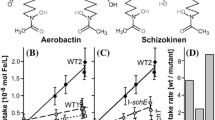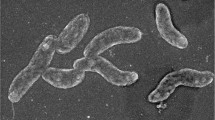Abstract
The l-ornithine-N 5-monooxygenase structural gene (SidA gene, accession number: FJ769160) was isolated from both the genomic DNA and cDNA of the marine yeast Aureobasidium pullulans HN6.2 by inverse PCR and RT-PCR. An open reading frame of 1,461 bp encoding a 486 amino acid protein (isoelectric point: 7.79) with calculated molecular weight of 55.4 kDa was characterized. The promoter of the gene (intronless) was located from −1 to −824 and had three HGATAR boxes which were putative binding motifs for the respective DNA-binding motifs and one CATA box. The SidA gene in A. pullulans HN6.2 was disrupted by integrating the hygromycin B phosphotransferase (HPT) gene into Open Reading Frame of the SidA gene using homologous recombination. Of all the disruptants obtained, one strain S6 (∆sidA) did not synthesize both intracellular and extracellular fusigen so that it could not inhibit growth of the pathogenic bacteria Vibrio anguillarum and Vibrio parahaemolyticus. The disruptant S6 did not grow in the iron-deplete medium and seawater medium because cell budding was stopped, but could grow in the iron-replete medium with 10 μM Fe3+ and Fe2+. H2O2 in the medium was more toxic to the disruptant S6 than to its wild type HN6.2. Thus, we infer that the fusigen produced by the marine-derived A. pullulans HN6.2 can play a unique role in chelating, uptake and concentration of iron to maintain certain proper physiological functions within the cells and secretion of siderophore may represent an efficient tool to eliminate competitors to compete for limiting nutritional resources in marine environments.








Similar content being viewed by others
References
Baakza A, Vala AK, Dave BP, Dube HC (2004) A comparative study of siderophore production by fungi from marine and terrestrial habitats. J Exp Mar Biol Ecol 311:1–9
Bradford MM (1976) A rapid and sensitive method for quantitation of microgram quantities of protein utilizing the principle of protein–dye binding. Anal Biochem 72:248–253
Buzdar MA, Chi Z, Wang Q, Hua MX, Chi ZM (2011) Production, purification and characterization of a novel killer toxin from Kluyveromyces siamensis against a pathogenic yeast in crab. Appl Microbiol Biotechnol. doi:10.1007/s00253-011-3220-8
Chi ZM, Liu GL, Zhao SF, Li J, Peng Y (2010) Marine yeasts as biocontrol agents and producers of bio-products. Appl Microbiol Biotechnol 86:1227–1241
Eisendle M, Oberegger H, Zadra I, Haas H (2003) The siderophore system is essential for viability of Aspergillus nidulans. Functional analysis of two genes encoding l-ornithine N 5-monooxygenase (sidA) and a non-ribosomal peptide synthetase (sidC). Mol Microbiol 49:359–375
Eisendle M, Schrettl M, Kragl C, Mulle D, Illmer P, Haas H (2006) The intracellular siderophore ferricrocin is involved in iron storage, oxidative-stress resistance, germination, and sexual development in Aspergillus nidulans. Eukaryot Cell 5:1596–1603
Haas H (2003) Molecular genetics of fungal siderophore biosynthesis and uptake: the role of siderophores in iron uptake and storage. Appl Microbiol Biotechnol 62:316–330
Haas H, Martin Eisendle M, Gillian Turgeon BG (2008) Siderophores in fungal physiology and virulence. Annu Rev Phytopathol 46:149–187
Hof C, Eisfeld K, Antelo L, Foster AJ, Anke H (2009) Siderophore synthesis in Magnaporthe grisea is essential for vegetative growth, conidiation and resistance to oxidative stress. Fung Genet Biol 46:321–332
Holinsworth B, Martin JD (2009) Siderophore production by marine-derived fungi. Biomet 22:625–632
Johnson L (2008) Iron and siderophores in fungal–host interactions. Mycol Resear 112:170–183
Labbe S, Pelletier B, Mercier A (2007) Iron homeostasis in the fission yeast Schizosaccharomyces pombe. Biomet 20:523–537
Philpott CC (2006) Iron uptake in fungi: a system for every source. Biochim Biophys Acta 1763:636–645
Renshaw JC, Robson GD, Trinci APJ (2002) Fungal siderophores: structures, functions and applications. Mycol Res 106:1123–1142
Sambrook J, Fritsch EF, Maniatis T (1989) Molecular cloning: a laboratory manual, 2nd edn. Cold Spring Harbor Laboratory Press, Beijing, pp. 367–370 (Chinese translating ed.)
Schrettl M, Bignell E, Kragl C, Sabiha Y, Loss O, Eisendle M (2007) Distinct roles for intra- and extracellular siderophores during Aspergillus fumigatus infection. PLoS Pathog 3:1195–1207
Schrettl M, Kim HS, Eisendle M, Kragl C, Nierman WC, Heinekamp T, Werner ER, Jacobsen I, Illmer P, Yi H, Brakhage AA, Haas H (2008) SreA-mediated iron regulation in Aspergillus fumigatus. Mole Microbiol 70:27–43
Slightom JL, Metzger BT, Luu HT, Elhammer AP (2009) Cloning and molecular characterization of the gene encoding the Aureobasidin A biosynthesis complex in Aureobasidium pullulans BP-1938. Gene 431:67–79
Tomlinson G, Crujckshank WH, Viswanatha T (1971) Sensitivity of substituted hydroxylamines to determination by iodine oxidation. Anal Biochem 44:670–679
Wang L, Yue L, Chi ZM, Wang X (2008) Marine killer yeasts active against a yeast strain pathogenic to crab Portunus trituberculatus. Dis Aquat Organ 80:211–218
Wang W, Chi ZM, Chi Z, Li J, Wang XH (2009a) Siderophore production by the marine-derived Aureobasidium pullulans and its antimicrobial activity. Biores Technol 100:2639–2641
Wang W, Chi Z, Liu G, Buzdar MA, Chi ZM, Gu Q (2009b) Chemical and biological characterization of siderophore produced by the marine-derived Aureobasidium pullulans HN6.2 and its antibacterial activity. Biomet 22:965–972
Watanabe H, Hatakeyama N, Sakurai H, Uchimiya H, Sato T (2008) Isolation of industrial strains of Aspergillus oryzae lacking ferrichrysin by disruption of the dffA Gene. J Biosci Bioengineer 106:488–492
Yamada O, Nan S, Akao T, Tominaga M, Tanabe H, Satoh T, Enei H, Akita O (2003) dffA gene from Aspergillus oryzae encodes l-ornithine N 5-monooxygenase and is indispenable for deferrichrysin biosynthesis. J Biosci Bioengineer 95:82–88
Zhang FL, Chen JX, Chi ZM, Wu LF (2006) Expression and processing of Vibrio anguillarum zinc-metalloprotease in Escherichia coli. Arch Microbiol 186:11–20
Acknowledgment
This work was supported by Grant 31070029 from National Natural Science Foundation of China.
Author information
Authors and Affiliations
Corresponding author
Rights and permissions
About this article
Cite this article
Chi, Z., Wang, XX., Ma, ZC. et al. The unique role of siderophore in marine-derived Aureobasidium pullulans HN6.2. Biometals 25, 219–230 (2012). https://doi.org/10.1007/s10534-011-9499-1
Received:
Accepted:
Published:
Issue Date:
DOI: https://doi.org/10.1007/s10534-011-9499-1




